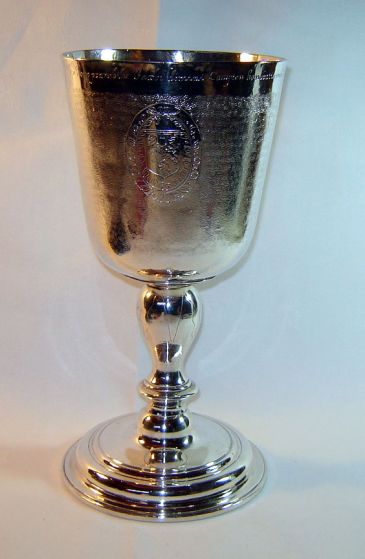1636 Standing Cup — Compton [23]
The deep beaker-shaped bowl is covered with granulated work, leaving the lip and the base of the bowl plain. The donor’s arms: [Sable] a leopard [or] between three helms [argent] with a label for difference, enclosed in a laurel wreath, are engraved in one of the two plain oval panels on the bowl, the other being engraved with the college arms in a shield.
The cup is inscribed around the lip in one line, “Ex dono prænobilis Jacobi domini Compton honoratissimi Comitis Northamptoniæ filij Natu: Maximi.”
The baluster stem, which is slightly engraved with a vandyke ornament, rests on a circular-moulded base.
Height, 30·8cm; depth of the bowl, 15·2cm; diameter of the mouth, 15·2cm; diameter of the base, 15·9cm.
London date-letter for 1636/7. Maker’s mark: R over W, with two mullets at the sides, and one below, in a plain shield.
Exhibited: 1895:49, 1931:58, 1951:51.
The donor, James Compton (1622–81), styled Lord Compton, who succeeded his father as third Earl of Northampton on the death of the latter at the battle of Hopton Heath, 19 March 1642/3, was admitted a Fellow-Commoner of the college, 21 January 1636/7. He, like his father, was a distinguished commander under the royal banner.
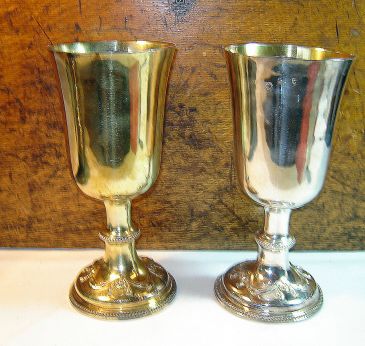 1637 Communion Cups [105a]
1637 Communion Cups [105a]
Pair of silver-gilt communion cups, of goblet form with bead mounts. Later embossed to foot with swags and paterae. Later engraved to foot “Ad Cultûs divini Decus. _ Coll: Regin: Cantab: 1775.”
Height 23cms. Weight 468 and 480 gms respectively. One with original gilding removed.
Hallmark 1637, maker’s mark indistinct.
Parts of a boxed communion set: see 1774. The inscribed date 1775 corresponds to the completion of the reconstruction of the Chapel interior in classical style, designed by James Essex (the younger).
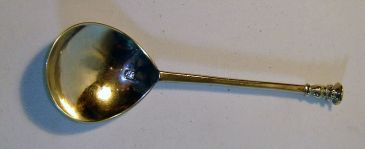 1639 Spoon — Lewis [64]
1639 Spoon — Lewis [64]
Charles I plain seal top spoon. Bowl added. Items [64] and [65] together in single case.
Weight 44 gms.
Makers mark rubbed. Hallmark 1639.
The donor in 1948 [Queens’ College 1947–48, p. 20] was The Revd Lionel Smithett Lewis (1867–1953) Matric. 1888, B.A. 1891, M.A. 1896. Deacon 1891, priest 1893. Curate: Cheltenham 1891–95, St Gabriel’s, Pimlico 1895–99, St Paul’s, Clifton, Somerset 1899–1900, All Saints’, Mile End New Town 1900–07. Vicar: St Mark’s, Whitechapel 1907–21, St John-the-Baptist, Glastonbury 1921–.
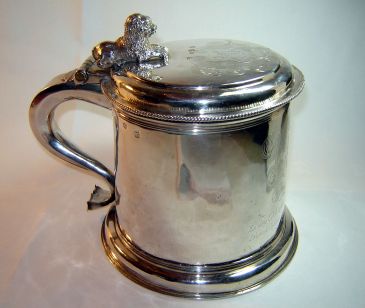 1674 Tankard — Bankes [25]
1674 Tankard — Bankes [25]
The large capacious body tapers very slightly from the moulded lip to the wide moulded base. The edge of the flat cover has a corded moulding. The thumb-piece is a large lion couchant. The handle terminates in a plain shield. In front of the body the donor’s arms, with feather mantling are engraved: [Sable] on a cross between four fleurs-de-lis [argent] five pheons [azure] and this inscription below: “Ex dono Caleᵬ: Bankes Armigeri Filij natu maximi // Iohannis Bankes Baronetti Comitatis Cantij Ano: Dni: // M·D·C·LXXV·” The boar’s head badge, with feather mantling, and “Coll: Regin:” are engraved on the cover.
Height: 17·1cm; diameter of the mouth: 15·2cm; diameter of the base: 18·7cm.
London date-letter for 1674/5. Maker’s mark: TL, with an escallop below, in a plain shield.
Exhibited: 1931:102.
The donor Caleb Bankes (1659–96), who was admitted to the college as a Fellow-Commoner, 27 April 1675, was the son of Sir John Bankes, first and last Baronet of Aylesford, Kent. He was admitted to Gray’s Inn, 2 Feb. 1675/6; M.P. for Queenborough, 1685–87, for Maidstone, 1689–90, for Rochester, 1691–95, and for Queenborough again from 1695 until his death, 13 Sept. 1696, at the age of 37. He married Elizabeth, daughter of Samuel Fortney of Chatteris in Cambridgeshire. His portrait is here.
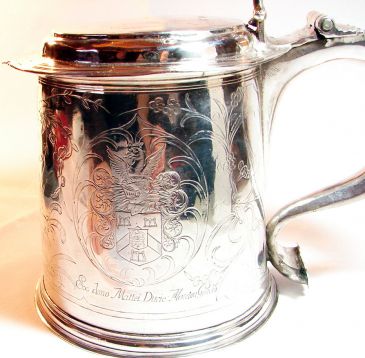 1682 Tankard — Moreton [24]
1682 Tankard — Moreton [24]
The bowl, which tapers slightly from the moulded lip to the moulded base, is engraved with storks and foliage in the Chinese taste, the flat cover being similarly decorated. The plain handle terminates in a flat shield, and the thumb-piece is a double scroll. The donor’s arms are engraved in an oval foliated cartouche on one side: [Argent] a cheveron [gules] between three square buckles [sable], for Moreton of Moreton. On a scutcheon of pretence are the arms of his father’s wife, Elizabeth Ducie: [Or] two lions passant [gules] (wrongly engraved as leopards). Crest — A moorcock’s head [or] with comb and wattles [gules] between two wings [azure]. It is inscribed below: “Ex dono Mattei Ducie: Moreton Generosi”. The college arms are in a similar cartouche, with “Coll: Regin: Cant:” inscribed above.
Height: 16·8cm; diameter of the mouth: 14cm; diameter of the base: 15·9cm.
London date-letter for 1682/3. Maker’s mark, P·M, with a pellet between, a star above, and a fleur-de-lis below, in a quatrefoil.
Exhibited: 1895:55, 1931:109.
The donor, Matthew Ducie Moreton (1663–1735), was admitted a Fellow-Commoner of the college 1681 June 27, and in 1720 was created Lord Ducie, Baron of Moreton.
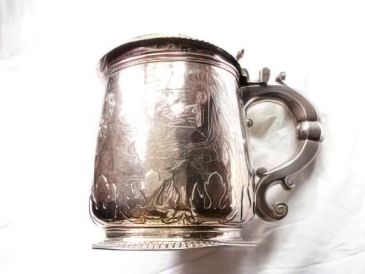 1684 Tankard — Fortrey [202]
1684 Tankard — Fortrey [202]
The body is plain, with a surbase of plain applied acanthus leaves, known as “cut-card” work, and it rests on a low foot, fluted at the edge, the lip being reeded. The flat cover, which is surmounted by a small plain knob, is decorated with a plain-rayed ornament of flat acanthus leaves, of the same style as those on the body. The thick scrolled handle is divided in the middle by a knob, the edges being square. The thumb-piece is a rayed fluting. The tankard is engraved with (1) the college arms in feather mantling, with “Coll Regin”; (2) the donor’s arms: [Argent] three boars’ heads [sable] cut off at the neck with [golden] tongues: the side-faced helm which has a floriated mantle is crested with two wings, with “Ex dono Jacobi Fortrey Armigeri”; and (3) the boar’s head badge, with feather mantling.
Height: 16·5cm; diameter of the mouth: 11·4cm; diameter of the foot: 13·3cm.
Hallmark London date-letter for 1684/5. Maker’s mark: F·P, with a pellet between and rose below, in an ornamental cartouche, for Francis Pile.
Exhibited: 1895:102, 1931:111, 1951:70.
The donor, James Fortrey (c.1656–1719), was admitted a Fellow-Commoner of the college 1691 April 29.
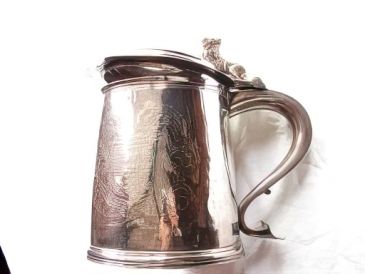 1688 Tankard — Sparke [201]
1688 Tankard — Sparke [201]
Hinged cover tankard with lion billet couchant thumpiece. Engraved with (1) arms of the donor; (2) “Ex dono Johannis Sparke Arm:”; (3) arms of the college with “Coll: Regin: Cant:” above.
Height: 185mm (excluding thumbpece), diameter of base 155mm. Weight: 1274 gms.
Hallmark London 1688. Maker’s mark: RC with 3 pellets above 3 below for Robert Cooper. London date letter l.
The donor, John Sparke (c.1673–1706/7), was admitted to the college as a Fellow-Commoner 1689 November 20. Possibly the John Spark who was M.P. for Newport, Cornwall, 1701 until his death in 1706/7 January 2.
![1693–4 Spoons [63] Photo of spoons](https://www.queens.cam.ac.uk/files/styles/small/public/1693_spoons_63_01391rot.jpg?itok=ZsQdMujN) 1693–4 Spoons — Buckmaster [63]
1693–4 Spoons — Buckmaster [63]
Two William and Mary trefid spoons with scroll backs and ends. One pricked on rear “ID // IG // 1693”. One pricked on rear “EH // AS // 1694” and engraved on front “W”. Both in one case.
Weight (2) 104gms.
West Country maker: sun within pricked dotted circle.
The donor was probably [Queens’ College 1947–48, p. 21], in 1948, Martin Arnold Buckmaster (1862–1960). His connection to the college is unknown.
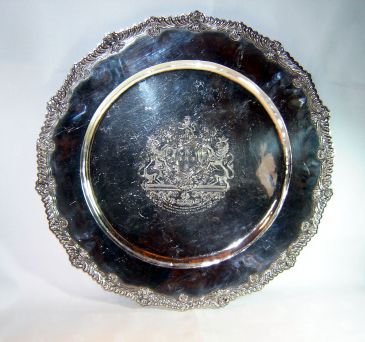 1699 Rose-water dish — Villiers [58]
1699 Rose-water dish — Villiers [58]
The dish is plain and circular, with a large depression, and a wide rim with a shaped gadroon and tulip border, divided by acanthus and shell ornaments in relief. It is engraved in the centre with the donor’s arms: [Argent] a cross [gules] with five escallops [or] thereon, and a crescent on a crescent for difference. Crest — A lion [argent] crowned [or]. Supporters — Two lions [argent] crowned [or]. Motto — FIDEI COTICVLA CRVX. Inscription: “EX⸱DONO⸱PRÆNOB⸱IWENIS⸱DO: GVIL⸱// VILLIERS⸱NOBILISS⸱VIRI⸱ED⸱COM // DE⸱IERSEY⸱F⸱NATV⸱MAXIMI”.
Diameter: 54·6cm. The weight marked is 87 ozs 2 dwts.
Exhibited: 1895:221, 1931:174.
Paired with the next item.
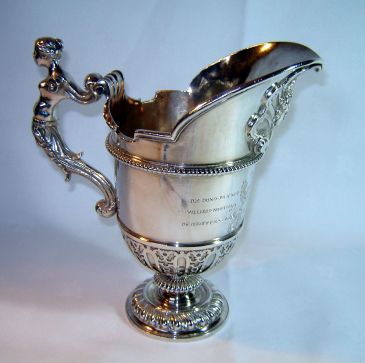 1699 Rose-water ewer — Villiers [58]
1699 Rose-water ewer — Villiers [58]
Paired with the previous item. The ewer is helmet-shaped, the plain body being divided by a bold beaded moulding at the top, and a plain square moulding lower down. Under the lip is a large, applied, scrolled shell-like ornament, with a large female mask in the centre. The lower part of the body is decorated with strap-work and acanthus leaves, and the short fluted stem rests on a circular foot, gadrooned at the edge. The handle is in the form of a female term, scrolled and foliated. The same arms and inscription, as on the dish, are engraved in front, with the motto, FIDEI COTICVLA CRVX.
Height: 23·8cm. It is marked with the weight 48 ozs 1 dwt.
London date-letter for 1699/1700. Maker’s mark, WI, with two stars above, and a fleur-de-lis below, in a shaped shield, for David Willaume.
Exhibited: 1895:221, 1931:174.
The donor William Villiers (c.1682–1721) was admitted to the college as a Fellow-Commoner 19 January 1698, and succeeded his father as second Earl of Jersey, 25 August 1711; he died 13 July 1721.
![1700 Toasting Fork given by John Courtenay [223] Photo of toasting fork given by Courtenay](https://www.queens.cam.ac.uk/files/styles/small/public/1700_toasting_fork_courtenay_223_0.jpeg?itok=MI0TjKnF) 1700(?) Toasting Fork — Courtenay [223]
1700(?) Toasting Fork — Courtenay [223]
The toast is inserted in a plain pointed wire frame and rests on a narrow hollowed plate, which is inscribed: “Ex Dono Johannis Courtenay ffilij // Natu maximi Johannis Courtenay de // West Moland in comitatu Devon // Armigeri.”
London date-letter for 1700/1 (unclear?). Maker, Anthony Nelme.
Total length: 109·5cm; length of handle: 88·9cm.
Exhibited: 1895:103, 1931:326, 1951:120.
The donor John Courtenay (or Courtney) was admitted a Fellow-Commoner 1707 April 15. Possibly the same person as John Courtenay (1687–1732), of the manor of Molland, Devon.
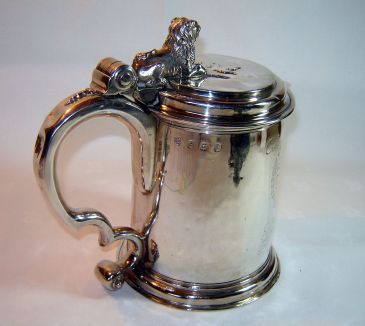 1703 Tankard — Smyth [26]
1703 Tankard — Smyth [26]
The body slightly tapers from the moulded lip to the moulded base. The flat cover, which has a moulded border and a pointed front, has a lion couchant thumb-piece, the fore paws resting on a flat, plain, appliqué leaf ornament. The thick scrolled handle, which terminates in a barrel-shaped knob, beaded at the ends, has a short tapering beading on the shoulder, attached to the large barrel-shaped joint. The donor’s arms, in a foliated and scrolled frame, are engraved in front: [Sable] a fesse dancetty [argent] billetty [sable] between three leopards [argent] (wrongly engraved as lions) each rampant against a flaming altar [or]. Crest— A salamander collared with a crown. The following inscription is below the arms: “Ex Dono Edvardi Smyth Commensalis // Filij Edvardi Smyth Baronetti de Hill // Hall in Comitāt Esſex:” The college badge, in a similar frame, is also engraved, this inscription being above: “Coll: Regin: // Cantab:”
Height: 18·1cm; diameter of the mouth: 12·7cm; diameter of the base: 15·7cm..
London date-letter for 1703/4. Maker’s mark, GA, with a coronet above, and a crescent below, in a shaped shield, for George Garthorne.
Exhibited: 1931:119.
The donor Edward Smyth (1686–1744), was admitted to the college as a Fellow-Commoner, 16 June 1703, and succeeded his father, Sir Edward Smyth, as third baronet of Hill Hall in 1713. The Smyth baronets of Hill Hall were descendants of a brother of Sir Thomas Smith (1513–77), Fellow.
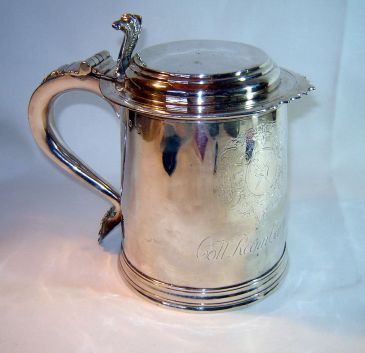 1704 Tankard — Wilson [27]
1704 Tankard — Wilson [27]
The body tapers slightly from the moulded lip to the moulded base. The flat cover is moulded at the border and is scalloped in front. The thumb-piece is a double scroll, notched in the centre, the back chased with an acanthus leaf; and the handle terminates in a plain shield. It is inscribed: “Donavit Guɫ: Wilson // Dñi Guɫ: Wilson de // Eastborne in Com̅. // Sussexiæ Barntti // Filius Natu Maximus”. The donor’s arms in a foliated scroll frame are engraved above the inscription: [Sable] a leaping wolf with three stars [or] in the chief; the boar’s head badge, in a similar frame, are engraved above this inscription: “Coll: Regin: Cantab:”.
Height: 17·5cm; diameter of the mouth: 12·7cm; diameter of the base: 14·3cm.
London date-letter for 1704/5. The maker’s mark is illegible, perhaps M.
The donor, William Wilson (d. 1713), was the eldest son of Sir William Wilson, second baronet, and was admitted to the college as a Fellow-Commoner, 29 June 1700. He died before his father. This family became Maryon-Wilson in 1899.
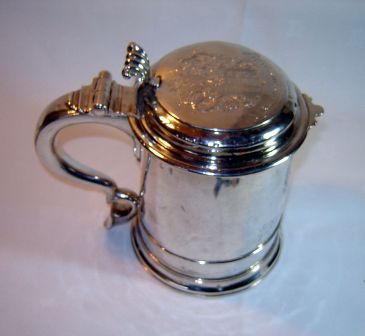 1707 Tankard — Rowlands [28]
1707 Tankard — Rowlands [28]
Plain straight sided flat topped tankard and cover with small lip. Engraved on the front with the arms of the donor and “Ex dono Thomæ Rowlands Generosi // filii Davidis Rowlands de Hinton Hall // in Comitatu Cantabrigiensi Armigeri”. Engraved on the cover with the College arms and “Coll: Regin: Cantab”.
Height 18cms. Lid diameter 15cms.
Made by Robert Cooper. London 1707.
The donor Thomas Rowlands was admitted as Fellow-Commoner on 18 March 1705/6.
![1716 Pair of Candlesticks [210] Photo of candlestick](https://www.queens.cam.ac.uk/files/styles/small/public/1716_candlesticks_210_0.jpeg?itok=8-3U6g5A) 1716 Pair of Candlesticks [210]
1716 Pair of Candlesticks [210]
A pair of Britannia silver candlesticks (one pictured). The baluster stems are plain, and they rest on moulded hexagonal bases which are engraved with (1) an entwined monogram, possibly of the donor; and (2) on the opposite side, the college arms, under which is inscribed “Queen’s Colledge”. The circular nozzles are later additions, on which are engraved a small boar’s head badge.
Height: 19cm. Weight of pair: 852g.
Hallmark London date-letter for 1716/7. Maker’s mark: GR, with a crown above, for David Green.
Exhibited: 1895:136, 1931:253, 1951:107.
The donor has not been identified.
![1717 Taperstick [211] Photo of taperstick](https://www.queens.cam.ac.uk/files/styles/small/public/1717_taperstick_211_0.jpeg?itok=0sCRX02Z) 1717 Taperstick [211]
1717 Taperstick [211]
Brittania silver hexagonal form taperstick. Engraved with the boar’s head in shield on base.
Height: 110mm, weight 96 gms.
Hallmark London date-letter B for 1717. Maker’s mark SL with pellet below, for Gabriel Sleath.
Exhibited: 1895:137.
![1717 Caster, large [214] Photo of caster](https://www.queens.cam.ac.uk/files/styles/small/public/1717_caster_214a_0.jpeg?itok=AeHRqaLC)
![1717 Caster, small [214] Photo of caster](https://www.queens.cam.ac.uk/files/styles/small/public/1717_caster_214b_0.jpeg?itok=SQwXTSlT) 1717 Two Casters [214]
1717 Two Casters [214]
Britannia silver plain octagonal Casters, engraved with boar’s head badge, and “COLL⸱REGIN”.
Height: (larger) 21.6cm, (smaller) 16.8cm. Weights: 470g and 220g.
London date-letter for 1717/8. Maker’s mark: AD, in a shaped cartouche, for Charles Adam.
Exhibited: 1931:231, 1951:100
![1796 Dessert Spoons [65] Photo of spoons](https://www.queens.cam.ac.uk/files/styles/small/public/1796_spoons_65_01389rot.jpg?itok=VvKg9tnv) ca. Georgian Spoons — Lewis [65]
ca. Georgian Spoons — Lewis [65]
Two plain seal top spoons with Georgian hall marks, the seal tops added later. See also inventory item [64].
Weight (2) 74gms.
The donor was probably [Queens’ College 1947–48, p. 20], in 1948, The Revd Lionel Smithett Lewis (1867–1953) Matric. 1888, B.A. 1891, M.A. 1896. Deacon 1891, priest 1893. Curate: Cheltenham 1891–95, St Gabriel’s, Pimlico 1895–99, St Paul’s, Clifton, Somerset 1899–1900, All Saints’, Mile End New Town 1900–07. Vicar: St Mark’s, Whitechapel 1907–21, St John-the-Baptist, Glastonbury 1921–.
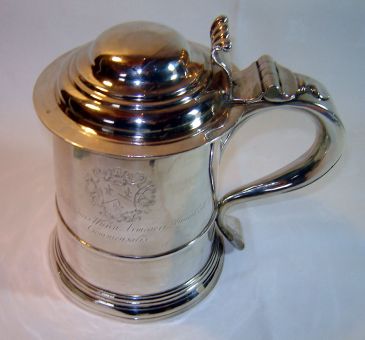 1721 Tankard — Wynn [29]
1721 Tankard — Wynn [29]
Plain straight sided domed top tankard and cover. Engraved on body with (1) the arms of the donor, with “Ex Dono Joannis Wynn Armigeri, Hujus Coll: Socio // Commensalis”; and (2) the arms of the College with “Coll: Regin: Cantab:”.
Height 20cms. Weight 932 gms. Scribed 32=6.
Made by Bowles Nash, 1721.
The donor, John Wynn (or Wynne) (1701–1773) was admitted to the college as a Fellow-Commoner on 1720 June 17. On the death of his father in 1749, he became the 2nd Baronet of Glynllifon and Bodvean.
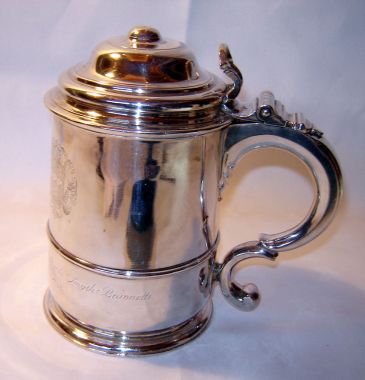 1728 Tankard — Smyth/Smijth [30]
1728 Tankard — Smyth/Smijth [30]
Plain straight sided domed top tankard and cover. Horseshoe thumbpiece. Engraved with (1) the boar’s head badge with “Coll. Regin. // Cantab.” above; (2) the arms of the donor; and (3) below both arms “Ex Dono Edwardi Smÿth Commensalis, Filii Edwardi Smÿth Baronetti, // De Hill Hall in Comitãt Eſsex. 1728”.
Height: 22cms. Weight: 1624gms.
Made by Francis Nelme, son of Anthony Nelme, Hallmark London, date-letter ‘N’ for 1728.
The donor Edward Smyth (1710–1760) was admitted to the college as a Fellow-Commoner 1728 June 16. He was son and heir to Edward Smyth (1686–1744), 3rd Baronet, who had been the donor of the 1703 tankard. On the death of his father in 1744, he became 4th Baronet of Hill Hall. It is unclear from the inscription in italic script whether the affected spelling of “Smyth” uses a double-dotted ‘ÿ’ or a ligated ‘ij’. Printed records use ‘ij’, but that might be because British printers of that period did not have a double-dotted ‘ÿ’ in their repertoire. In cursive handwriting, it is difficult to tell the two apart. The affected spelling “Smijth” appears to have begun during the lifetime of Edward Smyth senior, before 1720, as his fourth child onward is recorded with surname “Smijth” [Pedigree of Smijth of Hill Hall Essex, by Henry Farnham Burke & Joseph Jackson Howard, 1891]. So this item of silver, dated 1728 both by hallmark and inscription, is consistent with the “Smijth” spelling having started around 1710–20.
![ca. 1730 Knives [237] Photo of knives wrapped in cloth](https://www.queens.cam.ac.uk/files/styles/small/public/1730_knives_etc_237_0.jpeg?itok=gJnUVKRq)
![ca. 1730 Knives and forks [238] Photo of knives wrapped in cloth](https://www.queens.cam.ac.uk/files/styles/small/public/1730_knives_forks_238_0.jpeg?itok=kFdmKZN8) ca.1730 Knives & Forks [237] [238]
ca.1730 Knives & Forks [237] [238]
[237]: 8 Table knives, 8 cheese knives, 3 pairs carvers, with scroll-end pistol handles. Marked with Castle and Wreath badge; no college mark.
Maker’s mark: mainly DD in two overlapping circles. Circa 1730.
[238]: 9 small knives, 13 small two-prong forks, with leaf-end pistol handles.
Marks rubbed: possibly boar’s head badge.
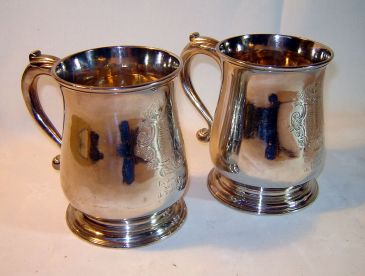 1731 Pair Pint Mugs — Weller [32]
1731 Pair Pint Mugs — Weller [32]
A pair of plain bellied pint mugs. Engraved with the arms of the College and of the donor, with “Ex dono Georgii Weller // Socii Commensalis // de Tonbridge Comit: Cantii”.
Weight: 772 (2) height: 12cms.
Made by Joseph Smith, hallmark London 1731.
The donor George Weller (1710–78) [later Poley-Weller] was admitted to the college as Fellow-Commoner 1728 October 3. Matric. 1728. Adm. Middle Temple 1725, called 1739, Bencher 1760, Reader 1771.
![1739 Marrow Scoops [74] Photo of marrow scoops](https://www.queens.cam.ac.uk/files/styles/small/public/1739_marrow_scoops_01347.jpg?itok=Qo8l470D)
![1739 Marrow Scoop [248] Photo of marrow scoop](https://www.queens.cam.ac.uk/files/styles/extra_small/public/1739_marrow_scoop_248_0.jpeg?itok=30G0-Mx8) 1739 Marrow Scoops [74] [248]
1739 Marrow Scoops [74] [248]
Plain marrow scoops. Engraved with the boar’s head badge.
Weight: 124gms (2), 62g (1). Length: 20cms.
Maker: Philip Roker II. Hallmark London 1739.
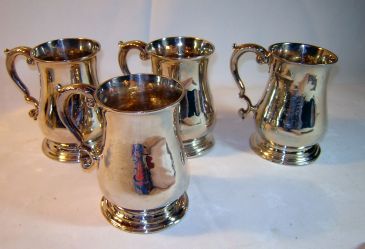 1745 Mugs — Polhill [33]
1745 Mugs — Polhill [33]
A set of four three-quarter pint plain bellied mugs. Engraved (1) with the arms of the College with “Coll. Regin. Cantab.”; and (2) with the arms of the donor with “Ex dono // Caroli Polhill de Chepstead // in agro Cantiano Arm̅ Soc Com. // 1745”.
Height 12.5cms, weight 1360gms.(4)
Made by William Grundy, 1745.
The donor Charles Polhill (1725–1805), of Chipstead, was admitted to the college as a Fellow-Commoner in 1745. He is not listed in Venn’s Alumni.
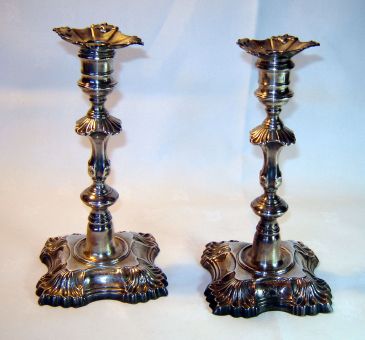 1748 Pair Candlesticks — Kent [2]
1748 Pair Candlesticks — Kent [2]
A pair of George II cast candlesticks with tulip stems, circular knop and shaped square bases with shell corners. Engraved with the boar’s head badge, the arms of (Egleston) the donor, and inscription “Carolus Kent Armr: // Soc: Commens // Coll:ii Regin:s // Sociis DD”.
Height 23cms. Weight 1568 gms.
Maker’s mark W·G for William Gould. London date-letter ‘n’ for 1748.
The donor was probably Charles Egleton (?1743–1811), who was admitted to the college as pensioner 1762 April 23. Upon inheriting the Fornham estate from his maternal uncle in 1762, he adopted the name Kent. He was created Baronet of Fornham St Genevieve in 1782. The hallmark date precedes the donor’s time at college.
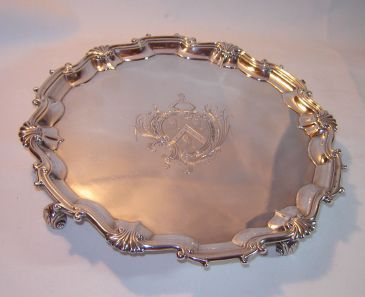 1749 Salver — Comyns [62]
1749 Salver — Comyns [62]
Shaped circular shell and scroll border salver on four volute feet. Engraved with the arms of Comyn: [Azure], a chevron Ermine between three garbs [or], with a crescent for difference, and a crest of two arms embowed, holding a garb [or].
Diameter 28cms. Weight 830gms.
Maker: John Taite. Hallmark London 1749.
Formerly kept within a wooden case on which a brass plate recorded: “Bequeathed to Queens’ College Cambridge by William Comyns Clifton 1913”. The donor William Comyns Clifton (1848–1913) was a solicitor practising in Romford, with no direct connection with the college. His will included:
… I give and bequeath to the President and Fellows of Queens College Cambridge the silver salver bearing the Arms of the Comyns family as my great great uncle Chief Baron Comyns was a member of the College together with his engraved portrait date 1745 …
Sir John Comyns (spelled Cummins in records at Cambridge) (c.1667–1740) was admitted as a pensioner 1683 June 5. Admitted to Lincoln’s Inn 1683 May 5, called 1690. M.P. for Malden 1701–08, 1710–15, 1722–26. Kt 1726. Baron of the Exchequer 1726, of Common Pleas 1735/6. Lord Chief Baron of the Exchequer 1736.
The relationship between Sir John Comyns and William Comyns Clifton was not as close as stated above in the will: they were in fact 2nd cousins 4 times removed, with their most recent common ancestor being Robert Comyns (1577–1644). The last Comyns surname in the line of descent to William Comyns Clifton was Elizabeth Comyns (before 1695–c.1770) within whose lifetime lies the hallmark date of this salver. There is a plausible line of descent for any family heirloom left by Elizabeth to have reached her great-great-grandson William Comyns Clifton, who had no siblings, no first cousins, did not marry, and had no children.
From 1987 this piece was listed as “missing since 1986” in silver audits. This was perhaps because it was not recognised as being item [62] owing to two errors in the description for that item in silver inventories from 1959 onwards. In the meantime, this piece was erroneously assigned number [64], a number already in use for a spoon of 1639.
